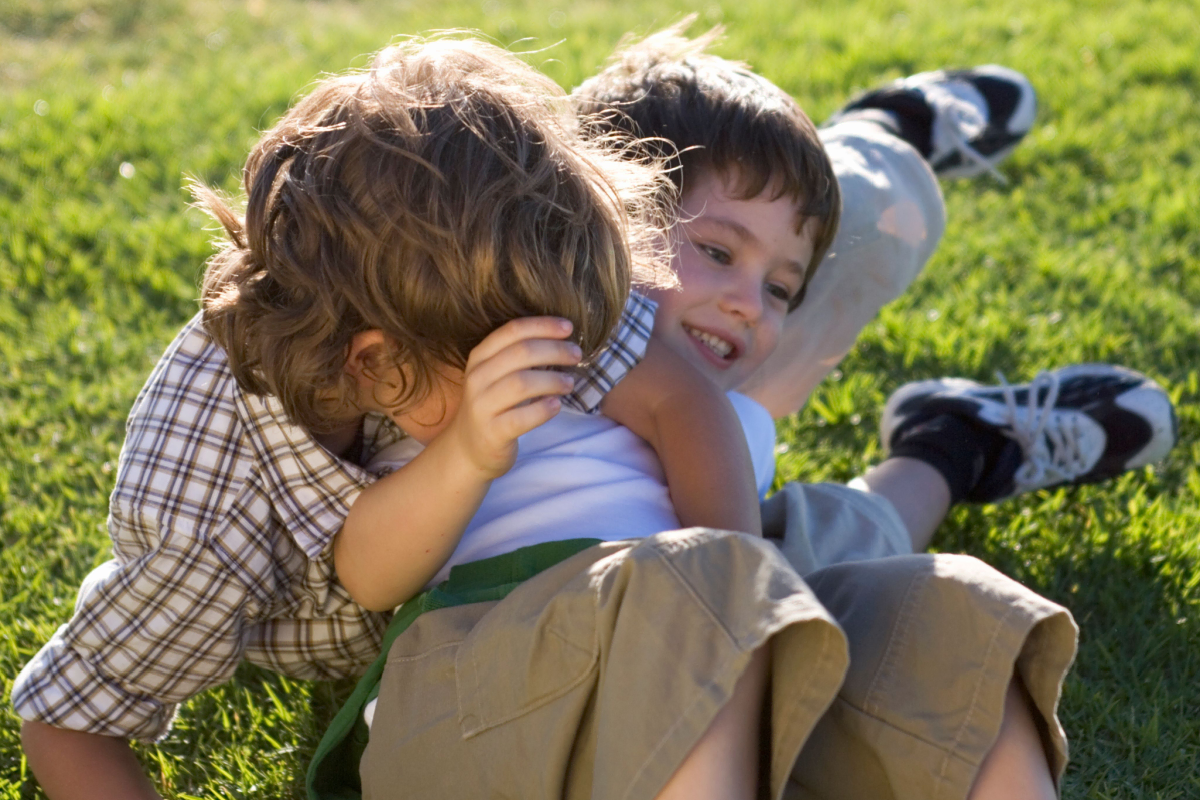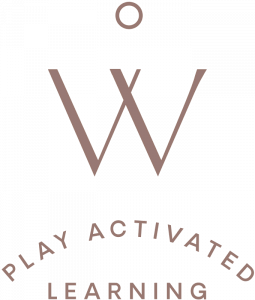In this insightful article by Dr. Stuart Brown, we’ll delve deep into the world of rough and tumble play and its vital role in early childhood education. As early years practitioners eager to embrace play-based approaches, understanding the incredible prosocial outcomes of this dynamic play style is absolutely essential. Let’s explore together how rough and tumble play fosters empathy, social skills, and brings lifelong learning benefits to our young children.
The Importance of Rough and Tumble Play for Social Development
In the African Serengeti, some years ago, while exploring animal play in the wild for the National Geographic Society, I saw two young lionesses engaged in what appeared to me to be a full on fight. But the accompanying Geographic seasoned animal behaviorist patiently described to me that what we were observing was not a real fight, but a “normal” non-aggressive important interaction; a complex but a very separate and necessary part of a lion developing interpride animal play behavior. She called it a “play-fight.”
And indeed, later as we looked at films of this episode, these lionesses had exhibited a specific pattern of very robust playful behavior. They were soft-eyed, curvilinear in their mutual, highly vigorous rough and tumble ballet and, neither their claws nor fangs were extended; when the episode ended they retreated non-combatively, remaining friendly pride mates. Not a real fight.
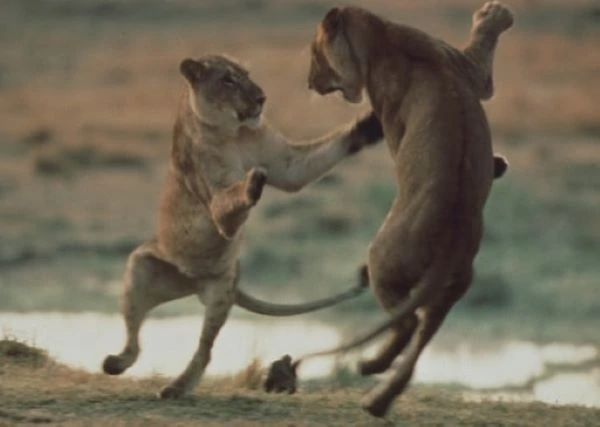
Paraphrasing Beth Kelley’s extensive article, “Just Wrestle – How We Evolved Through Rough and Tumble Play,” she says, this form of truly fundamental and powerful play is universal in mammals, and is found in others as well.
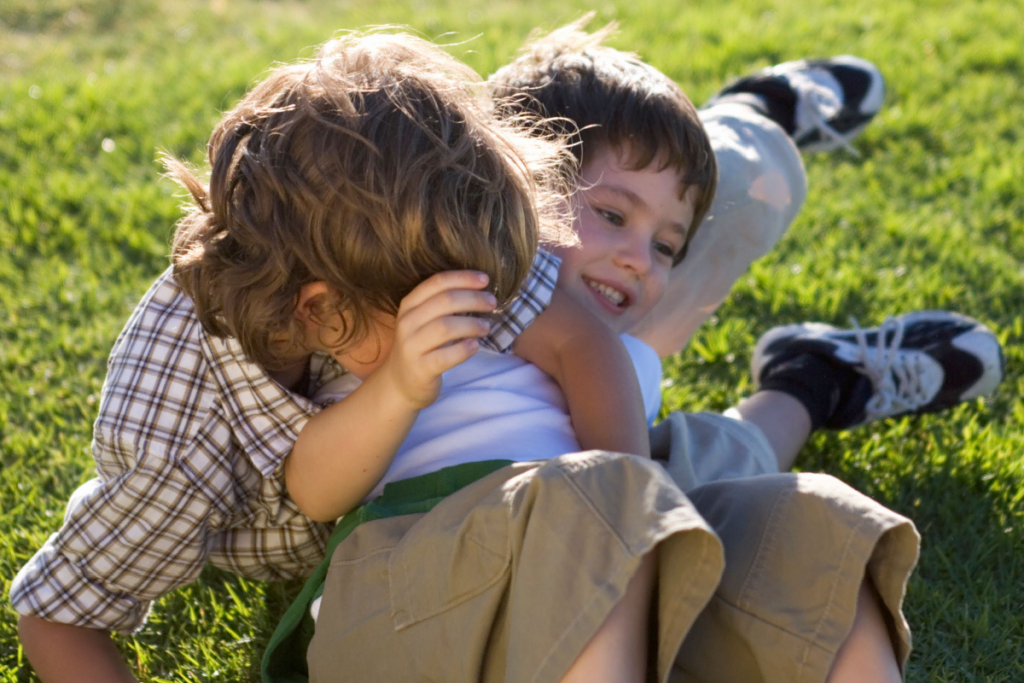
The Prosocial Benefits of Rough and Tumble Play in Early Childhood Education
Rough & Tumble play helps prepare humans for the complexities, tensions and nuanced behaviors required for our highly social species to successfully navigate their lives. My observations and research indicate that rough & tumble has become a heavily repressed form of play in the US. It is important that rough & tumble play be recognized as a normal, necessary developmental pattern – not anarchy or unbridled aggression. All parents and others caring for children in early and mid childhood should be aware of this truth.
Rough & tumble play primes the creation of many neural networks in the brain, and is an important component that contributes mightily to social competency. It teaches humans the limits of their bodies – how to move and interact with others, how to develop rhythm and coordination, strength, agility, and more. Parents, teachers and care-takers need to know of its nature and importance.
My studies of humans at play throughout our long lifetimes reveal that even though more common in kids, other manifestations of rough and tumble play such as good natured needling can continue throughout life as a means of alleviating social tension and fostering bonds between individuals.
Fostering Bonds and Social Skills: The Role of Rough and Tumble Play in Early Childhood
Research on rough and tumble play in animals (and its extension to humans) has shown that it is a fundamental interactive behavior necessary for the development and maintenance of social awareness, cooperation, fairness and a sense of belonging. In my personal reviews of its presence or absence – gained from taking thousands of lifetime play histories – I have found that even in small amounts, rough and tumble play has prosocial outcomes. In particular I believe that it provides an entrée’to and a sustaining aspect of self identity. Though the development of empathy and altruism requires cultural-moral modeling, the readiness to embrace these “civilizing” practices is catalyzed by healthy rough and tumble play. Rough and tumble play has broad prosocial implications that could mitigate our too-often vengeful world and certainly our current polarized society.
The role of rough and tumble play in the development of empathy began occurring to me while studying the background of a mass murderer, then subsequently the backgrounds of young incarcerated murderers. They demonstrated, by our careful review of their play histories, the absence of rough and tumble play in their often difficult lives, as compared to the play histories of demographically matched similar law-abiding others. That early research on violent antisocial men and the finding of their severe play deficiencies sensitized me to look more deeply at play itself, its nature and its impact on our lives. I have remained curious about play since those early studies and feel very fortunate for the opportunities I’ve had over my 50+ year odyssey of play discovery. Since founding the National Institute for Play in the early 1990’s my exploration of play behaviors has expanded greatly and my early findings have been validated from many sources, for which I am grateful.
Play Science and Early Childhood Education: The Value of Rough and Tumble Play
As play scholars continually conduct more and more objective studies in controlled animal play experiments, a new discipline, Play Science is beginning to emerge. This focus has relevance for all humanity as the findings consistently point to the benefits of healthy play, and the consequences of its deficits.
The behavioral and brain size outcomes resulting from the presence or absence of roughhousing, (play fighting, or rough and tumble – R&T -play,) has been particularly well documented by Sergio and Vivien Pellis and other animal play scholars. They have, through careful observations of animal rough and tumble play and through controlled experiments, established the necessity of R&T play for brain size, synaptogenesis and establishment of competent pack, pride or group social functioning.
When R&T rat play is severely limited, the Pellis’s have demonstrated, those deficient in it exhibit multiple social incompetencies. They cannot “belong” or take their places in the hierarchy of the pack, and when interacting are avoidant or hyper aggressive.
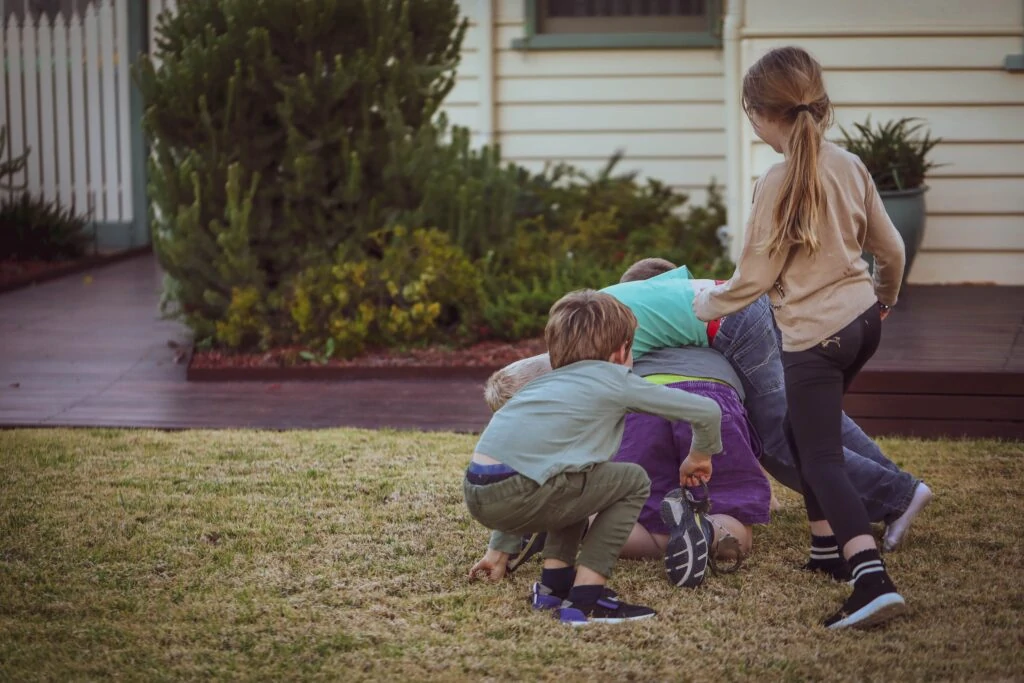
We humans are certainly not rats, but the evidence from their objective research is similarly found in other species, and has likely linkages to play deprivation in humans.
In addition, Pellligrini’s extensive studies of children’s playground play, Joe Frost’s personal communication about his 30 years of observations of children’s playground play, and my own examination of rough and tumble through many clinical reviews are all consistent with the laboratory research of Pellis’s and other animal play scholars. I view the animal play discoveries and the children playground findings as parallel. Though we humans are a different species with a huge and unique upper brain layer – our cerebral cortex – we nonetheless share the same basic neurotransmitters and subcortical brain wiring as our animal cousins. The motivation for sustained behaviors arises from these subcortical areas in both animal and human brains.
Recognizing and Encouraging Rough and Tumble Play in Early Childhood
When play in general, and rough and tumble play in particular is severely absent or richly available, the clinicial evidence – from the tragic stories of isolated Romanian orphans to the magnificent accomplishments of Nobel laureates for whom work and play are indistinguishable – demonstrates to my eyes the social imperative that these findings of Play Science result in new public practices.
Normal rough and tumble play behaviors such as chasing, hitting, diving, wrestling, helcking and teasing appear, to untrained eyes, to be aggressive and thus cause most adults to interrupt those patterns of play. Children, particularly at preschool ages, would benefit greatly if parents, child caretakers and preschool teachers could appreciate the importance of and learn to recognize the signs of rough and tumble play – smiles and happy interplay between friends who continue to be friends after the rough behaviors end. Of course, adult supervision should be there to disrupt actual hurtful aggression, but those supervisors would provide a developmentally positive service by not interfering when the children are happily rough housing.
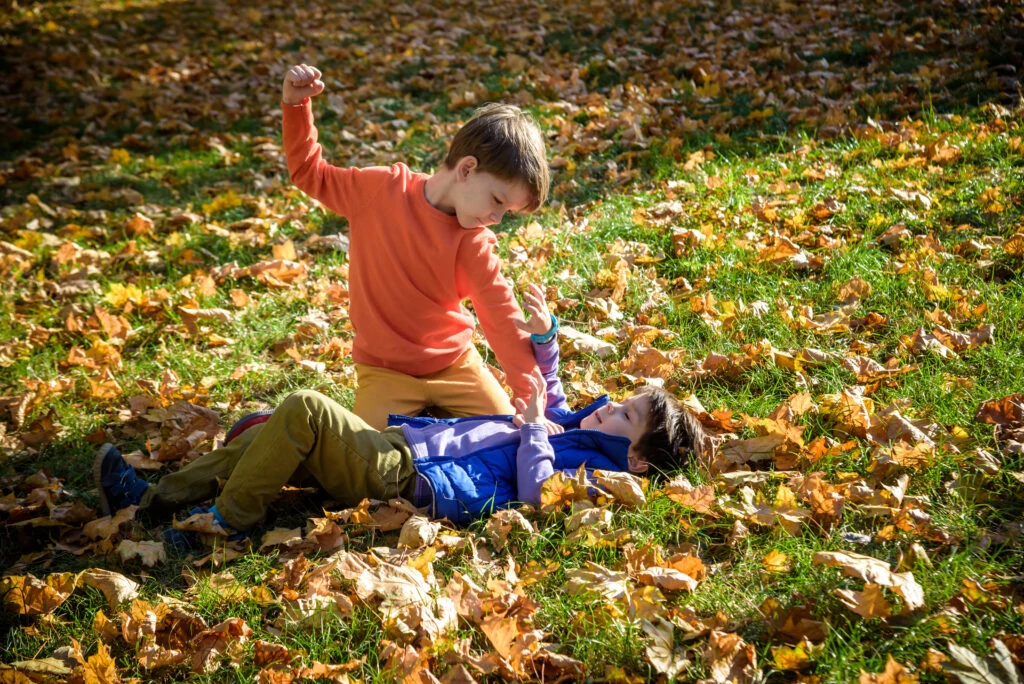
A natural extension of rough and tumble play in older youngsters – as it naturally diminishes with age – is ongoing involvement in joking, games, sports and group activities that both tolerate and foster creative tension. For example, many middle schoolers would rather debate than eat. Adults’ lack of experience with this pattern of play results in their interrupting the kids’ give and take behaviors; those interruptions not only reduce the development of their social mastery, but also has been linked to their having poor control of violent impulses in later life.
Personal Vignette:
It used to be that self-chosen, self-organized play were the principal activities of young people. Most adults over the age of 45 likely have memories of pick up games and exploring on their own – through puddles and fields or on city streets – told only to be home by dinner or before dark.
Without becoming too deeply immersed in nostalgia, the pickup games of my own youth were typical of those that spontaneously occurred in vacant lots and parks across the country. They had their own style and etiquette, were full of interruptions, reversals, flexibility and changing rules. Despite the seeming anarchy, these games existed within an overall, agreed-upon sense of structure, and fairness. They were undertaken with an accepted, minimal risk of damage, and had safeguards. While there was considerable mayhem and noise during the course of these games, I remember them as exciting, and without blatant aggression. In fact, the neighborhood bullies who had reputations for being aggressive or troublemakers were not included in the pickup games.
These games certainly let me know who I was: autumn-football in the Gunn family’s vacant lot was my training ground. It was there I realized I was feisty, but vulnerable, a fast, shifty runner, but not a gutsy tackler or courageous blocker like my older brother. I needed his protection and that of his friends to take on the challenge of the games, and they freely offered it. It was terribly important to get in the game, and belong. I remember feeling…fierce. It was OK to cry if you got hurt, but not OK to cheat or whine. Not OK to make fun of one of your own team members, but OK to ridicule someone on the other team. If team members changed in the middle of the game, it was OK to verbally humiliate the former teammate.
After these games we discussed the great plays and the incredibly lucky plays. We each had our own verbal highlight riffs, letting kids shine for a few moments in the spotlight for their abilities. We also let the screw-ups know in clear language their deficiencies.
I can attest that these child-chosen, child-organized, independent experiences have had major effects on my perceptions of myself, my capabilities and confidence as an adult. And that was also the case for most all the other boys who were involved in those games. Dougie was a star, and became a big ten half back, and later a major coach. The other star, Linnie faded athletically as he started high school, but his academic interests, and tinkering nature led him into dentistry. Jimmy, unathletic and overweight was assigned referee status but he had an important function in the overall game, and “belonged.” He became a lawyer. Looking back now, with the retrospective eyes of a trained psychiatrist, these play-inspired portraits of others and myself feel more real, persistent and predictive of life to come than most any other molding experience. Certainly, parents and mentors are pivotal, but the self that emerges through play is the core authentic self. And those “free play” settings were pivotal.
My systematic studies of the play deprived and the research of others confirm that these kid-organized games and other rough and tumble play experiences have significant positive long-term developmental impacts. Unfortunately, research is also showing that those child-chosen, child-organized, independent activities are becoming more rare. Most suburban kids now are ferried from music lessons to tutors to soccer practices each activity organized and overseen by adults. This is not all bad. I think that in many ways the relationship between kids and adults, kids and their parents, is much closer than in my day. But something very significant is missing.
My last trip to suburban Chicago and the old neighborhood revealed no empty lots, no pick-up games, a lot of adult supervised youth sports, busy kids and parents, many more and much nicer cars, less street noise, clearer air, mixed ethnic groups in sidewalk restaurants, and multiple families living in the big Victorian houses. Not the same world. Talk to kids on the street (when they can be found) reveals that they are generally more hip, glib, are inevitably texting on cell phones, and more comfortable with adults and authority than I remember any of my neighborhood buddies.
The National Institute for Play
REFERENCES
Scott, Eric and Panksepp, Jaak (2003). Rough-and-Tumble Play in Human Children. Aggressive Behavior, 29:539
Burgdorf, J., Kroes, R. A., Beinfeld, M. C., Panksepp, J., & Moskal, J. R. (2010). Uncovering the molecular basis of positive affect using rough-and-tumble play in rats: A role for insulin-like growth factor I. Neuroscience, 168, 769–777
Panksepp, J. (1998). Affective neuroscience: The foundations of human and animal emotions. New York, NY: Norton
Pellis, S.M., & Pellis, V,. (2009) The Playful Brain – Venturing to the Limits of Neuroscience oxford, Oneworld Publications.
